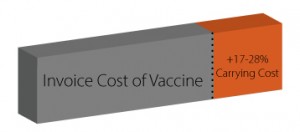Are your vaccine payments large enough to cover the cost of administering them?
If your answer is 'no,' you're not alone. Between 47 percent and 79 percent of vaccines are money-losers, once the indirect expenses associated with giving vaccines - storage, wastage, back-up systems, administrative costs etc. - are factored into the original purchase price.
If your answer is 'yes' - meaning you break even or even make money on vaccines, you're on the right track, and your practice is a stellar example of how closely monitoring the business side of the office literally pays off.
To squeeze the most out of your vaccine payments, you must first do the math, which includes determining all those overhead costs.
 The true cost of vaccines can be up to 28% higher than the invoice
The true cost of vaccines can be up to 28% higher than the invoice
The AAP, in its Business Case for Pricing Vaccines, estimates that indirect vaccine expenses range from about 17 percent to 28 percent of the purchase price of the vaccines. Knowing the range gives you an idea of how much more you should add to the cost of buying the vaccine.
Chip Hart, PCC's Director of Pediatric Solutions, estimates the indirect costs are even higher - somewhere, he says, in the 20 to 30 percent range.
"As always, I encourage people to start doing the math," Hart advises practices. "Look at what your practice pays for the product and your reimbursement. If you're not being paid 20 to 30 percent more than your direct costs for the vaccine, you're surely losing money."
If your practice has run the data and determined it is losing money, there are several ways to improve reimbursement, such as renegotiating private contracts, coding and documenting properly, and pre-authorizing insurance eligibility before administering vaccines.
Hart also encourages clinicians to join the AAP's Section on Administration and Practice Management (SOAPM), which gives a collective voice to those working toward minimizing vaccine-related costs.
"Fifteen years ago, immunizations represented 5 to 10 percent of billing for our clients. Now it's 20 percent or more because there are more vaccines to give out and the costs have gone up," Hart says. "It used to be a money-maker for practices; now it's a dangerous threat to their finances."



